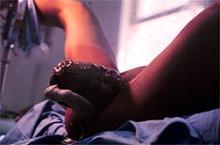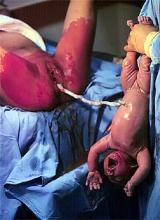The Lying Down Delivery
What do we see in lying down deliveries? There is a woman straining, with her legs up, looking up at the ceiling.
The only animal in the evolutive scale that has its birth in a lying down position, with “four legs up” is the woman. There is no other in nature. A pregnant ewe, put on her back, dies. If a female monkey is made to lie downs during labor, her uterine contractions stop. I heard this from scientists in obstetrical physiology, Prof. Nicolas Assali, from UCLA, and Prof. Caldero Barcya, from the Motevideo school.
You observe the baby’s head pointing to the ceiling.
A child which has to come down is in a position to go up!
The baby is pressed when passing through the vaginal passage, and that forces the amniotic liquid in the lungs to be expelled.
There you can see two difficulties in the position.
The first is that the child, if it comes out alone, on a table so high, will fall to the floor.
The second is that head is higher than the rest of the body. Its torax is compressed. When it comes out, it breaths in, expanding the lungs and sucking in the liquid that was not expelled. That is causes the need for artificial respiration after birth, with the doctor’s help.
Slapping the baby has been a common practice for a long time. Even today the baby is held up by the feet. The justification for this is to avoid the aspiration of liquids. Put yourself in the place of the newborn: to be slapped and be held up by your feet with your head down, for some reason you don’t even know.
The placenta also doesn’t come out by itself on the lying down deliveries.
The medical intervations (to hold the baby, turn it round, etc.) are obstetrical manoeuvres. There are several, bearing the names of each of the doctors that, over the course of the years, invented them.
For instance, to turn the baby as soon as it is born, and leave it on its side, was stressed by De Lee, allowing to avoid the newborn sucking liquidin or, if it hypotonic, that its tongue “falls behind” and it suffocates.
It is beautiful to see the child being born turning around and ending its movement spontaneously on its side.



